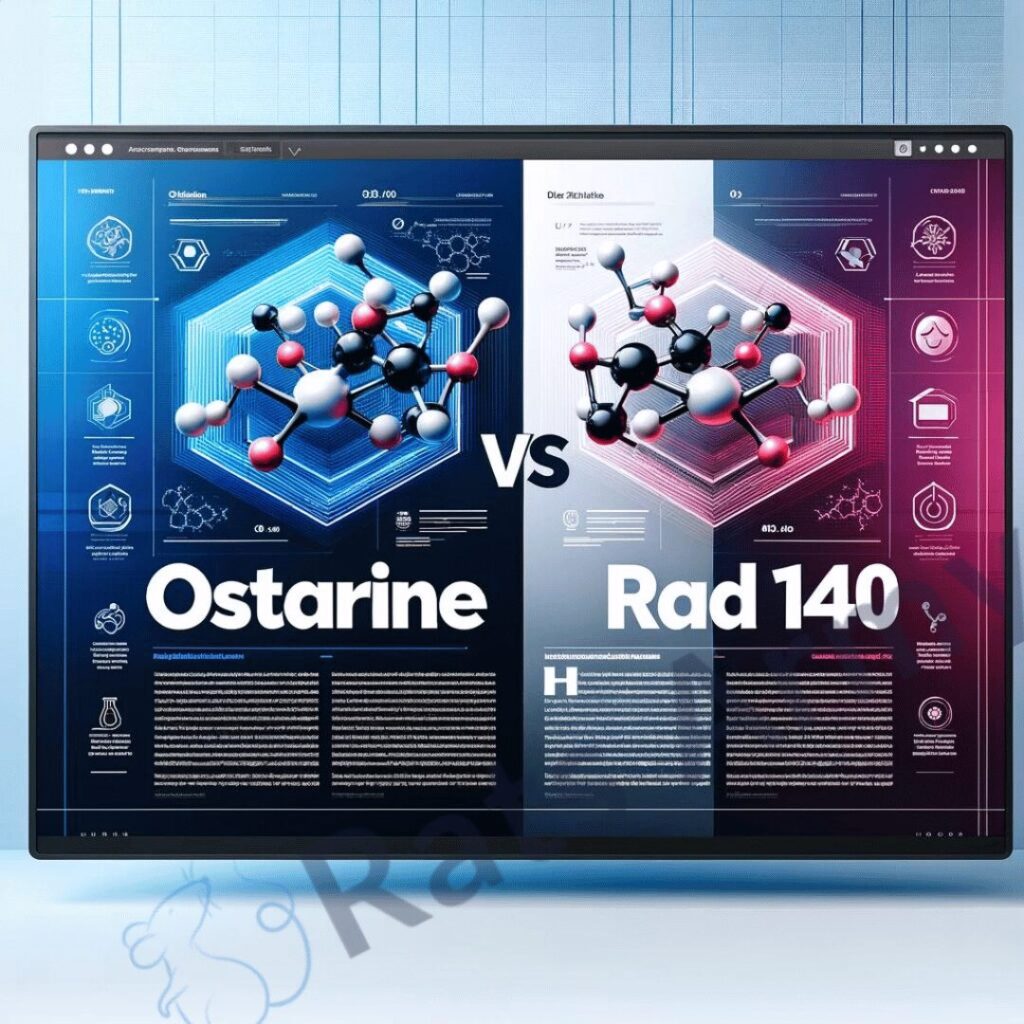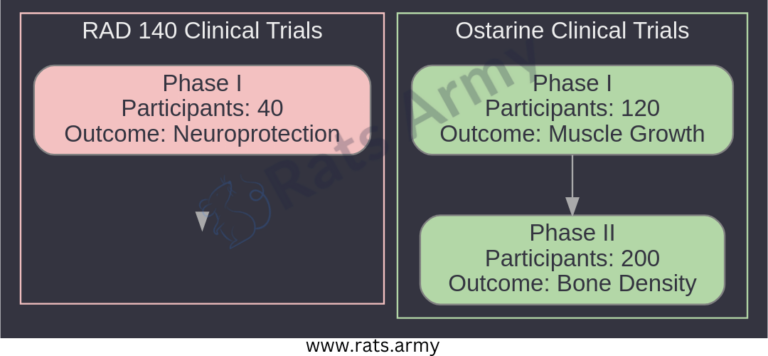Exploring the nuances of SARMs, this article delves into the key distinctions and considerations between Ostarine vs RAD 140.
We will compare their efficacy, side effects, and user experiences to help you understand which might be better suited for your research or therapeutic needs.

Table of Contents
ToggleIntroduction to SARMs and Their Regulatory Status
Selective Androgen Receptor Modulators (SARMs) represent a class of nonsteroidal drugs that are under intense scientific investigation for their potential to mimic the effects of testosterone.
SARMs are known for their ability to selectively target androgen receptors in certain tissues, which ideally reduces unwanted side effects compared to traditional anabolic steroids.
However, due to their ability to enhance muscle growth, SARMs are banned by most sports organizations and anti-doping agencies.
Neither RAD 140 nor Ostarine, two prominent types of SARMs, are approved by the FDA for human consumption; they are strictly limited to research purposes.
Comparing RAD 140 and Ostarine: Key Differences
RAD 140 (Testolone) and Ostarine (MK-2866) are among the most discussed SARMs due to their distinct characteristics and stages of research.
RAD 140 is known for its potent effects even at lower doses compared to Ostarine.
It is currently less studied, with research primarily in phase I clinical trials.
On the other hand, Ostarine is in multiple phase II trials, indicating more advanced research stages.
Ostarine’s side effects are generally milder, and it also demonstrates potential in healing connective tissue, a notable difference from RAD 140, which shows possible cognitive benefits and is being researched for its potential effects on Alzheimer’s disease.

Clinical Trials and Research Progress
Both RAD 140 and Ostarine are involved in various clinical trials aiming to uncover their therapeutic potential for conditions like Alzheimer’s disease, muscle wasting, osteoporosis, and certain cancers.
Despite these ongoing studies, neither compound has progressed beyond the investigational stages in humans.
Their legal status remains confined to research use, as neither has been approved by regulatory bodies for medical treatments due to the need for more comprehensive data on their efficacy and safety.
Potential Benefits and Ongoing Research
The ongoing research into RAD 140 and Ostarine is exploring benefits that could outweigh their risks.
RAD 140 has shown potential in lowering LDL (bad cholesterol) and protecting against neurodegeneration in early studies.
Ostarine has been observed to increase lean muscle mass and enhance bone density, making it particularly interesting for treating conditions like osteoporosis.
Both SARMs are studied for their anti-cancer potential as well, with RAD 140 focusing on breast cancer and Ostarine on prostate cancer.
Exploring the Side Effects of RAD140 vs Ostarine
While both SARMs show promise, their potential side effects are a major area of concern.
Preliminary research indicates possible risks such as suppression of natural testosterone levels, which can lead to various hormonal imbalances and side effects like muscle weakness, mood changes, and impaired sexual function.
The FDA has also highlighted severe risks from SARMs generally, including liver toxicity, heart attack, and stroke.
They failed to give any evidence.
The complete spectrum of long-term effects remains unknown, necessitating cautious progression in clinical trials.
However, honestly, what does the FDA really know?
They gave emergency authorization to a drug that is causing heart attacks to minors.
Empirical evidence from user experiences on forums like Reddit highlights not only the side effects but also the dosages and cycle lengths that individuals employ when using RAD 140 and Ostarine. These real-world data points offer insights into how users are managing these SARMs in practice.
Real-World Experiences with Side Effects
User experiences vary significantly, with some reporting severe side effects like crushed estrogen levels, energy depletion, and other hormonal disturbances.
For instance, a user on RAD 140 noted it “destroyed my energy and crushed my estrogen,” which underscores the potent effects of this SARM on the body’s hormonal balance.
These insights from the community are invaluable in understanding not only the potential gains from these SARMs but also the serious side effects and the importance of managing dosage and cycle length meticulously to mitigate adverse outcomes.
Ostarine vs RAD 140 Experiences

Ostarine: Usage and Suppression Effects
For Ostarine, users suggest starting with a lower dosage, such as 10 mg daily, and consider increasing it after a few weeks based on tolerance and effects.
However, it’s crucial to note the suppressive nature of Ostarine as well.
One user reported significant testosterone suppression after just four weeks on 15 mg of Ostarine per day, with their testosterone levels dropping to below 200 ng/dl.
Despite its milder reputation, Ostarine can lead to full suppression of natural testosterone production by the eighth week, regardless of the dosage.
This supports the need for careful monitoring and potentially incorporating PCT to help restore natural hormone levels after completing the cycle.
RAD 140: Dosage and Cycle Recommendations
RAD 140 is often cited for its potent effects, and users generally recommend starting with a lower dose. Typical advice from experienced users suggests starting with 10 mg per day. As described by one user, a common cycle might look like this:
- Weeks 1-4: 10 mg of RAD 140 daily
- Weeks 5-6: Maintain 10 mg of RAD 140 daily, possibly introducing post-cycle therapy (PCT) agents to manage suppression
- Weeks 7-8: Continue with 10 mg daily and regular PCT
Another user recommended extending PCT post the RAD 140 cycle:
- Weeks 9-10: PCT only
- Weeks 11-12: PCT on alternating days
Such schedules highlight the need for careful management of side effects, particularly suppression of natural hormones.
Quality Assurance in SARMs Supply
Given the unregulated nature of the market, quality assurance in sourcing SARMs is critical.
Many online products claiming to contain SARMs fail to meet purity standards, with some lacking active ingredients entirely.
It is essential for researchers and consumers to source their compounds from reputable suppliers who adhere to strict quality control measures, including third-party lab testing, to ensure the compounds’ authenticity and safety.